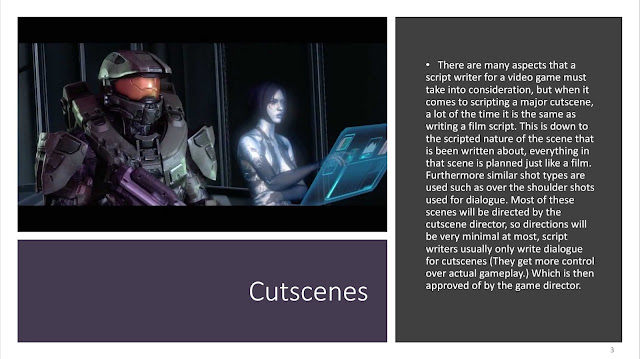Introduction to media
scripts.
Media types that use scripts include: Radio, TV, Movies, and
video games. This can be any part of these media types too! Such as for TV and
radio, it could be dramas and the news.
Scripts are a major part of media productions. Good scripts
are needed to ensure that there’s a narrative which is able to flow with the story.
Languages of script.
Modes of address: These can be defined as the ways in which
the script creates a relationship between the addresser and the addressee. In
order for this, communication would be key and provided through the scripts.
Producers must make assumptions about their target audient and therefore,
reflections of these assumptions will be portrayed within the scripts and made
clear. Different modes of address will be used for different target audiences.
Informal and formal modes are one form of mode of address,
although there are others. This can be seen by modes of addresses such as:
Point of view: This is mostly relevant to narrative fiction,
which includes the option of third person narrators or first person narrators.
Directness: If the viewer of the media is directly
addressed, than this would be a form of direct address.
Elaborate codes: This is language that includes technical
terms and is formal. This can include more specialist language.
Restricted code: This is language that is informal and
therefore, easy to understand. This can include spoken language used in TV
dramas.
Format and layout.
Script: A script is the most commonly used term. A script
can apply to a stage play, radio show or computer programming script.
Screenplay: This refers to a script for a TV programme and film.
This is usually anything intended for a screen.
Shooting script: When screenplays are finalised, they are
turned into shooting scripts in the pre-production stages. A shooting script
includes camera directions made by the director and cinematographer based on
their intentions for how the action is to be framed and overall look. This means
that a shooting script is a production tool so that all the crew know what to bring
and do ahead of filming.
The scene heading or slugline is able to tell the reader
where the scene will take place. There are two main choices to starts with,
indoors or outdoors. Once that is done, the name of the location is covered This
can sometimes be followed by the time and date. For example: INT. Hogwarts, Gryffindor
dormitory – Dusk.
Action: The action sets the scene, this generally describes
the setting and allows the writer to introduce the characters and set the stage
for the story. This isn’t always here, but if there’s something new in this
scene, it will be used. These will always be written in present tense, even if
it’s a flashback or a flashforward.
Character names: These will always be capitalised within the
script. This allows the characters to be clearly stated within the script and
therefore, gives the actors ques for when they should speak.
Dialogue: This is a generic term for when someone speaks.
This takes place when two or more people speak, if it’s one singular person, it
would be a monologue instead.
Parenthetical: This is a way to show what the character that
is speaking is feeling, what emotion they should portray and how they should
speak.
Extentions: This includes the words of O.S (Off screen), O.C
(Off camera), and V.O (Voice over) these are all for where the character is, if
they aren’t seen on the screen.
Transitions: These are indented to the far right of the script
for the editors to use when in the stages after production.
Shots: This shows where the camera will be facing, this
gives the cameramen prompts for where they should point the camera within the
production process.































